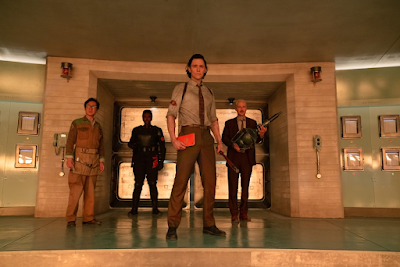Thy Kingdom Come! Batman and Superman are well and truly stuck into the world of Kingdom Come this issue as they not only have to deal with a cruel older version of David, but come into contact with that world's versions of themselves.
This issue does the age old comic book trope of the two sides that are both heroes having a misunderstanding and fighting each other. Whilst this is a trope that I'm not particularly fond of, this book manages to do it well by making it believable, and executing it in cool ways.Thanks to Thunderman claiming that these odd versions of Superman and Batman are villains trying to kill him the Earth-22 versions are quick to jump into the fight and help Thunderman out. The Earth-22 folks even go through some options as to what these new heroes might be, mentioning White Martians, and saying that anything they say to try to 'prove' themselves to be good mean nothing when telepaths exist. This leaves our Earth-0 heroes kind of stuck as no matter how much they ask for the others to just listen to their explanation it goes ignored.
This leads to some very cool fight scenes as our Superman and Batman go up against this world's versions of them. The two Supermen fight across the city, with ours eventually taking things underground in an old lead mine, trying to use it to get some distance from him counterpart. Meanwhile, Bruce has to go up against a more experienced Batman, who's using his new flight suit (Kingdom Come fans will recognise it instantly), and even has the help of Nightwing.
Mora makes these fight scenes look very cool, and whilst the powerhouse fight between the two Supermen might seem like the one that would be the coolest, it's the Batman fight that takes the cake. The way these two experienced fighters clash, predicting each others moves and trying to counter them, makes for some cool moments. I really like the fact that Mora puts speed lines on their movements, showing that this is two Batmen who are going all out for the fight, pushing as hard as they can.
The fight eventually ends with our heroes managing to get away, with Superman flying them to the Kent farm to take a breather and regroup. Unfortunately for them, the device needed to get home has been badly damaged in the fight, and they're stuck on Earth-22 for now. To make matters worse, A group of heroes arrives at the farm, ready to take them down. Meanwhile, in Metropolis, Thunderman, Batman, and Superman kneel before Gog, the ancient god from the Third-World.The last couple of pages of the book are some fantastic moments. I loved the huge splash page of the Earth-22 heroes. It's a great page to just sit and stare at, picking out who's there, and what their designs look like. Some of them are familiar, being very similar to their final Kingdom Come looks, whilst others are still on their way there, and there are some who we've just never seen before too. It also feels a little like certain characters were picked to appear based on who's popular and who's being pushed in other books at the moment too. Characters like Peacemaker, feel out of place until you realise he's in everything now.
Most interesting, however, is the inclusion of Gog, the god who first appeared in the Justice Society of America series in 2008. With Waid having created the Kingdom Come universe, but Geoff Johns and Alex Ross having created Gog in this form for that story I was surprised to see him here. Waid is clearly not being too possessive or precious of his original work, and seems happy to include what was created after. I'll be interested in seeing how he combines these stories, and what he brings from others work into his own.
Batman / Superman: World's Finest has been a hugely fun series since it began, with some stories that have introduced fun new history for these characters that we love; but this feels like the first story in the series that has a lot of weight, the most potential impact even though it's dealing with another universe. Perhaps it's because it's returning to one of the most beloved comic stories of all time, but this feels like one of those comics that you really don't want to miss out on.








































